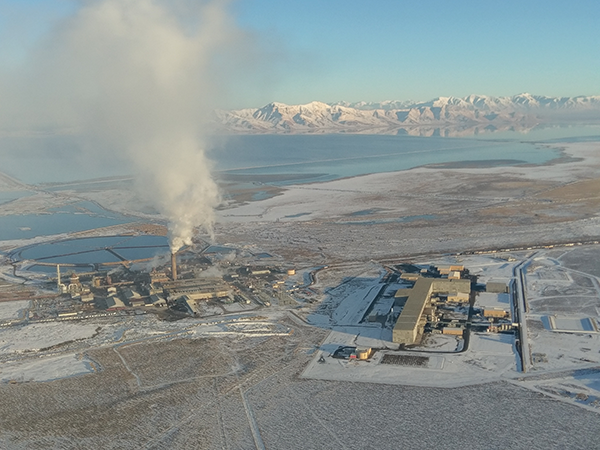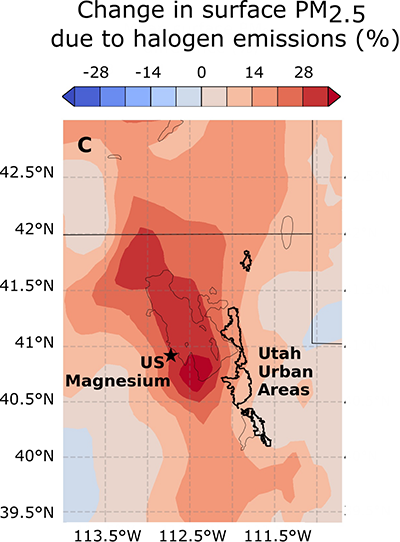A .gov website belongs to an official government organization in the United States.
A lock () or https:// means you've safely connected to the .gov website. Share sensitive information only on official, secure websites.
25 January 2023
adapted from the story by NOAA Communications

The 2.4 million people who live along Utah's Wasatch Front experience some of the most severe winter particulate matter air pollution in the nation. Now, analysis of measurements taken during NOAA research flights in 2017 indicates that emissions from a single source, a magnesium refinery, may be responsible for a significant fraction of the fine particles that form the dense winter brown clouds that hang over Salt Lake City.
The finding was published this week in the journal Environmental Science & Technology. Lead author Carrie Womack, a CIRES scientist working at CSL, said analysis of airborne measurements directly from the plume rising from the US Magnesium refinery during a 2017 winter air pollution study in Utah found that emissions of chlorine and bromine, known as halogenated compounds, were significant contributors to the persistent winter brown clouds.
US Magnesium, the largest magnesium producer in North America, extracts the metal from the brine of the Great Salt Lake, at a plant upwind of Salt Lake City.
Particulate matter contains microscopic solids or liquid droplets that are so small that they can be inhaled and cause serious health problems. Particles less than 2.5 microns in diameter, also known as fine particles or PM2.5, pose the greatest risk to health, affecting both lungs and your heart.
"Understanding what causes this PM2.5 formation is the first step in reducing it," Womack said. "One aspect of our study was characterizing known point sources in the area."
The Utah Division of Air Quality requires reporting of particulate precursors, such as chlorine and nitrogen oxide emissions, which are then shared with the U.S. Environmental Protection Agency. However, NOAA's measurements also identified significant emissions of bromine, a reactive chemical that is not required to be reported. Modeling demonstrated that the chlorine and bromine emitted by the refinery were responsible for 10 - 25% of regional PM2.5 during winter pollution episodes.

"Our measurements of chlorine and nitrogen oxides agree with what the facility reports to regulators," Womack said. "But what we found suggests that bromine industrial emissions may deserve a closer look."
Pollution control regulations and cleaner technologies adopted since the 1970s have steadily improved air quality in the U.S. Yet some valleys in the Intermountain West still experience high levels of PM2.5 during winter. In Utah's urban Salt Lake Valley, wintertime levels of PM2.5 exceed national air quality standards an average of 18 days per year. The majority of exceedances occur in December, January and early February during a period when strong, multi-day inversions known as persistent cold air pools develop that trap pollution close to the surface.
These exceedances have been specifically associated with adverse health effects in the region, including a 42% higher rate of emergency room visits for asthma during the latter stages of air pollution events from 2003-2008, according to a Salt Lake County, Utah study.
Prior to the NOAA study, the chemical composition of PM2.5 in northern Utah, and how it forms, had received considerably less attention than in other regions of the nation despite the severity of the problem in Utah.
"We could see during our research flights in 2017 that the air around the plant was unlike anything we had sampled previously due to the high chlorine emissions," said NOAA scientist Steven Brown, who led the field campaign. "We were surprised that it had such a large effect on winter PM2.5 across the entire region."
"Close to the plant, we didn't even need to check the instruments to know we were flying through the plume," Womack added. "We could smell it. It smelled like bleach!"
The dominant contributor to regional PM is ammonium nitrate, which is responsible for up to 70% of fine particulate mass during inversion periods and 40% outside of inversions. Ammonium nitrate is a secondary pollutant formed by reactions between ammonia, nitrogen oxides (NOx), and volatile organic compounds (VOCs). The NOAA model demonstrated that halogen emissions from US Magnesium speed up the conversion of NOx and VOCs to ammonium nitrate PM.
Researchers have shared their findings with Utah officials, who had sought NOAA's help in understanding their poor winter air quality. A previous study by Womack in 2019 documented other sources of winter smog. The Utah Department of Environmental Quality (UDEQ) is currently conducting a study to identify sources of ammonia.
While the new paper is based on measurements taken in 2017, Womack said emissions of chlorine, which accompany the unreported emissions of bromine, have not shown any sign of significant decline in the last five years.
Researchers from the University of Utah, the University of Toronto, the University of Washington, and the U.S. EPA also participated in the study.
The NBC affiliate in Salt Lake City reported on February 22 that a proposed Utah bill to address air pollution along the Wasatch Front received a last-minute amendment to study halogen emissions in direct response to Dr. Womack's timely publication. Dr. Womack testified to the legislative committee about her study and the underlying science just prior to the bill receiving a unanimous favorable vote from the committee.
Womack, C.C., W.S. Chace, S. Wang, M. Baasandorj, D.L. Fibiger, A. Franchin, L. Goldberger, C. Harkins, D.S. Jo, B.H. Lee, J.C. Lin, B.C. McDonald, E.E. McDuffie, A.M. Middlebrook, A. Moravek, J.G. Murphy, J.A. Neuman, J.A. Thorton, P.R. Veres, and S.S. Brown, Midlatitude ozone depletion and air quality impacts from industrial halogen emissions in the Great Salt Lake Basin, Environmental Science & Technology, doi:10.1021/acs.est.2c05376, 2023.
We report aircraft observations of extreme levels of HCl and the dihalogens Cl2, Br2, and BrCl in an industrial plume near the Great Salt Lake, Utah. Complete depletion of O3 was observed concurrently with halogen enhancements as a direct result of photochemically produced halogen radicals. Observed fluxes for Cl2, HCl, and NOx agreed with facility-reported emissions inventories. Bromine emissions are not required to be reported in the inventory, but are estimated as 173 Mg year–1 Br2 and 949 Mg year–1 BrCl, representing a major uncounted oxidant source. A zero-dimensional photochemical box model reproduced the observed O3 depletions and demonstrated that bromine radical cycling was principally responsible for the rapid O3 depletion. Inclusion of observed halogen emissions in both the box model and a 3D chemical model showed significant increases in oxidants and particulate matter (PM2.5) in the populated regions of the Great Salt Lake Basin, where winter PM2.5 is among the most severe air quality issues in the U.S. The model shows regional PM2.5 increases of 10%–25% attributable to this single industrial halogen source, demonstrating the impact of underreported industrial bromine emissions on oxidation sources and air quality within a major urban area of the western U.S.